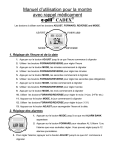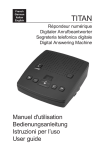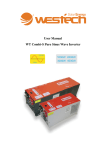Download Eye On Electronics - MOTOR Information Systems
Transcript
Eye On Electronics The recycling of just about anything that can be is widely accepted to be a good thing. But a large number of batteries may be getting recycled much sooner than is necessary. Mike Dale hicles, shop tools and even cell phones. With some help from that website and a few others, we can dig into this “refurbished” thing, to see what it really means. The trade group Battery Council International estimates that 98 million vehicle batteries are replaced in the U.S. each year; worldwide the number is more than 225 million. The primary function for most of these batteries was to run the starter motor and to act as reserve storage to supplement the alternator for short-term peak loads. But not all of the batteries replaced were actually defective. Battery University (BU) says that a leading German battery maker recently checked 400 starter motor batteries that had been returned and found that nothing was wrong with 200 of them. Another European battery manufacturer says that genuine failures for warranty returns is in the range of 5% to 7%. What this must mean is that there are a lot of discarded batteries that could be returned to useful service. Even some of the defective batteries could possibly be revived back to some level of performance. This is a business opportunity that some companies have been taking advantage of. This refers not only to starter motor batteries but to cell phone batteries, nickel-cadmium (Ni-cad) batteries and both lithiumion (Li-ion) and nickel metal-hydride (NiMH) electric car batteries. Franchises are springing up all This container of batteries—a rather large load of toxic over to rework these diswaste, actually—is ready for recycling. The question is, are carded batteries. there good ones in that pile that could be made useful again? There are at least three Photo courtesy Mack’s Recycling [email protected] T he local parts store here has the usual display of new car batteries. Two things are remarkable: One is that most of the new batteries are pushing well past the $100 mark, up sharply from just a few years ago. The other is the small sign that says the parts house also offers refurbished batteries for about $40. Refurbished? What does that mean? What really has been done to those batteries? What will the customers who buy them be getting for their money? A great website for information on batteries is www.BatteryUniversity.com, which offers a broad range of technical information on batteries and how they work. It covers car batteries, of course, but also batteries for electric ve- continued on page 20 18 May 2014 Eye On Electronics challenges in the refurbishment business. The first is testing. Somehow, those enormous piles of so-called bad batteries have to be combed through, tested and evaluated. The good ones can be cleaned up and prepared for resale. This testing is not simple; it takes equipment and training and can still leave gray areas of uncertainty. The second challenge is finding those batteries whose performance is truly not up to snuff. There are some techniques that can be used to bring them back to a reasonable level of performance. These batteries will need even more investment in terms of time, effort and technology than those that were never truly bad in the first place. In fact, you could make the point that there are more than enough still-good batteries out there to satisfy the market for lower cost refurbished batteries, so why bother trying to fix the others at all? The third challenge to refurbishment will be those batteries that are genuinely bad and unrepairable. This includes batteries with mechanical problems such as cracked cases, broken terminals and internal opens or shorts. This group includes the end-of-life batteries that are simply used up. These batteries are recycled. For recycling, batteries are disassembled and the metals salvaged. Doing this correctly is not without risk. Lead is toxic and battery acid is corrosive. A number of former locations for battery recycling plants (Haina in the Dominican Republic is one example) are well-known environmental hot spots. Problems include lead contamination in the soil, air and water. In Haina, they found that one-third of the soil in the area of the former battery plant was actually lead. So, how did all these good batteries get condemned in the first place? The BU website says that low charge and acid stratification are the most common causes of apparent battery failure. The low-charge circumstance is well illustrated by the typical use pattern for cars in Japan. Motorists there drive an average of 8 miles a day in congested cities. At typical low speeds, the batteries just never really get fully recharged. Poorly charged batteries are also a problem in large luxury vehicles. Electric power steering, electrically controlled suspension systems, HVAC systems and so on add loads to the battery. If the alternator does not spin fast enough and long enough to generate the needed power, then the battery has to supply that power. Depending on how a motorist uses his vehicle, the battery may be in a constant state of undercharge. The direct result of leaving a battery in a chronic undercharge state is sulfation. Sulfation is a phenomenon If all you wanted to do, is turn this off ...then any “ole code reader” would do! But if real diagnostics and fixing the TPMS is your goal... Then BARTEC is the TPMS tool partner you’ve been looking for! þ Innovation where it counts means better features þ Advanced diagnostics to fix it right the first time þ Better OBDII coverage for easier and faster relearns þ Real technical support means help when you need it Coming Soon! Industry’s First Wireless TPMS Service Tool visit: TIA INSIDE www.bartecusa.com call: Circle #13 20 May 2014 Bartec TPMS Diagnostics Keeps This Light Off! [855]877-9732 that occurs when small sulfate crystals form. By themselves, they’re harmless. However, during prolonged low-charge circumstances, the amorphous lead sulphate converts to a stable crystalline form that then accumulates on a battery’s negative plates. This leads to the development of large crystals that can block the active area of the plates. Sulfation lowers the rate at which a battery will accept a charge by effectively increasing the battery’s internal resistance. The website goes on to say that there are two kinds of sulfation—reversible and nonreversible. Soft sulfation can be reversed by applying an overcharge to a fully charged battery. The overcharge is on the order of 15 to 16V, controlled to a current of 200mA. It can take up to 24 hours to accomplish the desulfation, but it can restore capacity to the battery. This is one meaning of the term refurbished. The BU website shows a lot of respect for long, slow, careful charging of the battery. Fast charging can generate heat and, through electrolysis, cause gas to form in the battery. It can also cause water loss, plate warpage and other evils that may actually damage the battery. There are a number of chemicals, pills and even electronic equipment on the market devoted to removing sulfation. BU offers a method for using Epsom salts to accomplish it. There are a number of battery chargers that use AC currents to try to break up the sulfation. If a battery is left in an uncharged or partially charged condition for weeks or months, the sulfation can harden to the point where no form of restoration is possible. Acid stratification affects the electrolyte in the battery. For the typical car battery, the electrolyte is a mix of distilled water and sulfuric acid. In an undercharged battery, the heavier sulfuric acid concentrates at the bottom of the battery. This happens when the battery stays below 80% charge, never receives a full charge and has shallow discharges. With acid stratification, the electrolyte at the top of the battery limits plate activation because it doesn’t have enough acid. This promotes internal corrosion and reduces performance. The concentration of acid at the bottom makes the battery test as being more charged than it is. It also raises the open circuit voltage of the cells. Because there’s an uneven charge across the surface of the plate, the effective cold cranking amps (CCA) performance of the battery is reduced. The concentration of acid at the bottom of the battery also leads to sulfation on the lower half of the plates. Acid stratification cannot always be continued on page 62 FF310 Electrical Circuit FaultFinder Short and Open Circuit FaultFinder A faster and easier way to find short and open circuits: Connect the transmitter to the faulty circuit or wire Scan the circuit / wire with the tracer’s flexible probe to find the trouble spot 42 V Ready: works on circuits with 6 to 42 VDC Auto polarity probes For use with: Included in the set: Automobiles Buses and RVs Trucks and trailers Boats Any 6 to 42 VDC powered circuit Transmitter and tracer Mini, ATO and Maxi fuse socket connectors Professional cordless circuit tester Hard carrying/storage case User’s manual To watch demo video online and learn more scan the QR Code, visit us at www.gtc.ca or call toll free 1-800-440-5582 GTC, V Ready and FaultFinder are trademarks of General Technologies Corp. - © 2013 General Technologies Corp. Circle #14 May 2014 21 Eye On Electronics continued from page 21 avoided. The BU website cautions that during winter months, the starter motor batteries of most passenger cars dwell at 75% of a full charge level. If the driving routine for the vehicle cannot be altered, it may be necessary to do some external recharging. Stratification can also be broken up through a controlled overcharging process (up to 16V for one or two hours, not more). Tipping or shaking the battery is another way to redistribute the electrolyte. Note that the solution for acid stratification again involves a careful, controlled plan for charging the battery. Refurbishment really means restoring a battery’s storage capacity to an acceptable level. It does not mean taking the battery apart and replacing bits and pieces of it. Other problems can shorten the life of a battery. Internal mechanical problems include shedding, corrosion and internal shorts. Inside the cells of a battery are positive and negative grids that have been pasted with active materials. Over a battery’s life there’s a natural shedding of these materials, which then fall into the spaces at the bottom of the battery. As this lost material builds up, it eventually can form a bridge that shorts out the plates. Shedding can be limited by reducing the depth of discharge of the battery and the number of starter motor cycles. (The new start-stop systems can be hard on batteries.) Internal corrosion of a battery can be reduced by controlling its temperature and by choosing the right alloys of lead for 62 May 2014 the grids and straps. Batteries used in hot climates generally have a much shorter life than those used in moderate climates. Overcharging a battery can cause the water to split into hydrogen and oxygen (electrolysis) that can then escape the battery. This uses up water and can shorten the life of the insulators inside the battery if the water is not replenished. Probably the most difficult and technical aspect of the refurbishment business is battery testing. The Battery University website says that the leading health indicator for a battery is its capacity. Measured in amp-hours, capacity is the number of minutes a battery can supply a 25A load. Put another way, capacity is the amount of energy the battery can store. Cold cranking amps is a different measurement that refers to the power delivery rate the battery is capable of. BU says that the large number of warranty returns of stillgood batteries is partly to blame on the lack of reliable testers. Most testers read only CCA; the capacity is not measured and therefore not known. This means that resistive measurements are unreliable as a state-of-health indicator or end-of-life indicator. This leads to wrong diagnostics in which a good battery is replaced in error while one with low capacity is passed, only to fail on the road. The health of a battery cannot be exactly measured, only estimated, says BU. They say that there’s no one single tester today that’s fully capable of assessing the state of health of a battery in a single measurement. The most common battery test method uses a large resistor to put a load on the battery. The voltage output of the battery is monitored during this test. The problem with this method is that it cannot spot a poorly charged battery, or one with high internal resistance (sulfation) or lost capacity. Another problem is that the load resistor gets really hot and the test further drains the battery. As an alternative approach, various AC conductance testers are now on the market. These devices inject a sine wave or square wave pulse into the battery. Different makers use different frequencies and pulse rates. The idea is to measure the impedance of the battery as a way to gauge how well current can move in and out. This still doesn’t measure battery capacity, but it’s better than the load resistor method. Cadex, a company associated with Battery University, says there’s a method called electrochemical impedance spectroscopy (EIS) that would work to measure battery capacity. The problem with EIS is that it’s a complicated method that’s more appropriate to a research lab than a refurbishment operation. The equipment is expensive and it takes skilled operators to decipher the data. Cadex says it has built a hand-held, field-usable version of this they call “Multi-Model electrochemical impedance spectroscopy,” or “Spectro” tester, for short. It’s capable of measuring CCA to ±5% accuracy and capacity to ±20% accuracy. For starter motor applications, the evidence shows that there are literally tens of millions of batteries every year that are being recycled before their time. There’s money to be made from that pile. How good any refurbished batteries might be depends on technical quality of the charging and testing methods used to refurbish them.















